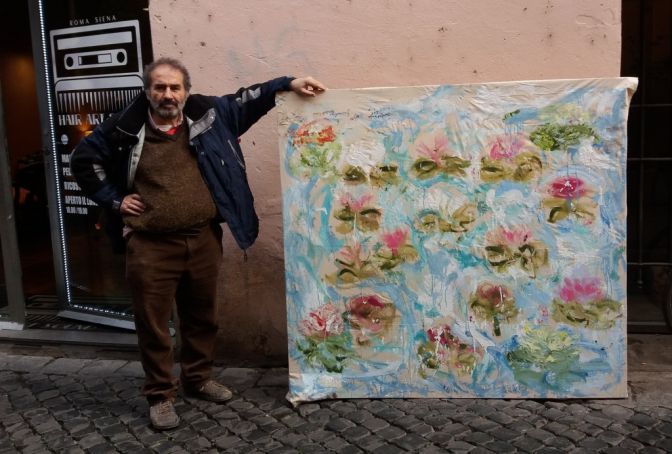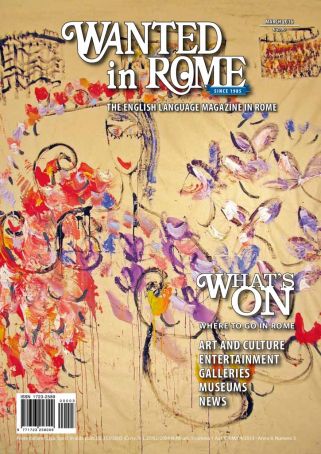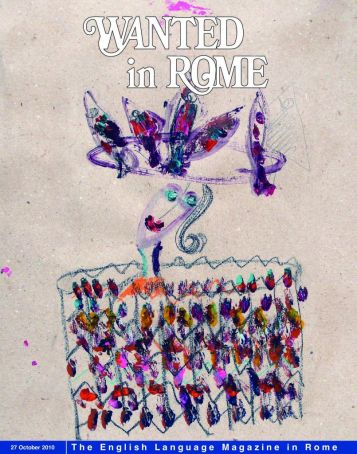Giancarlino's flower cycle in Via dei Cappellari brings back memories of a vanishing Rome.
By Mary Wilsey
“Sono andato in giro tutto il pomeriggio per le strade...” is the opening of the short story, Blumen, by Austrian novelist Arthur Schnitzler. That is exactly what I had been doing all afternoon. Schnitzler was walking in the Vienna snow; I was walking down the side streets of Campo de' Fiori one grey afternoon in January. He was mourning his one-time lover. I was mourning the city I love, a vanishing Rome, once cheerful, busy, warm, noisy, full of cooking smells, a happy place – a city that was nowhere to be seen on that winter's day.
49 Via dei Cappellari
A century and more after Schnitzler wrote Blumen he would probably have been just as surprised as I was to see flowers crowding a street-level window on Via dei Cappellari, one of the few remaining bastions of Rome's artisans. Not real flowers, but painted ones in a myriad of colours, shapes and sizes, all on creamy, unbleached linen and canvas, unframed and free, as alive in their own way as any real flower could be. It was a colourful spot, a happy sight on that drab winter afternoon. I tried the door. It was closed, but I felt a lifting of my mood as I walked on.
By chance the next day I bumped into the artist Giancarlino outside Caffè Perù, his local bar in Via Monserrato, next to the office of Wanted in Rome. “Have you seen my show? I'm going there now. Come as soon as you can, Via dei Cappellari 49,” he said with his usual enthusiasm and urgency. I should have guessed that the blossoms were his.
The inside of 49 is bursting with flowers, higgledy-piggledy over every available space, small works on shelves, long drifts of material, large expanses draped from the ceiling, blooms on the bottom of wooden crates from the nearby street-market, paintings all over the cellar downstairs. Bright reds and greens, outline blacks, soft yellows and ochres, alluring pinks and violets, stark peacock colours, all inspired by his muse.

Carlina and Andrea show the art they love
The small space seemed crowded and the conversation bubbled up, helter-skelter fashion, among those of us there: stories and more stories of Rome and art – happy art, commercial art, heartless art, new galleries, old galleries, disappearing trades, the travailed city in the grip of mafia corruption, economic disaster, incompetent politicians. The owner of the space, Carlina, relates that she and her husband Andrea want to escape and go where it is brighter and happier, perhaps to Crete. She admits that they are not the art-market types: they show the art they love, in their own house, when they want and for as long as it suits them. “How long will this show last?” I ask. “We haven't decided yet,” Carlina says, “perhaps until the beginning of March, perhaps until the end, perhaps even longer.”
For the moment they are in love with the art of Giancarlino and that of the other great Rome name, Fausto Delle Chiaie, best known for his elongated figures outlined in chalk on the pavements in Piazza Augusto Imperatore, his carefully placed boxes, re-found toys and pungent messages. You will see his lean figures, the outlines of a scurrying rat, a trap or two, as well as his latest inspiration, enshrouded mummies standing upright in the cellar. They could hardly seem more lifelike, friendly bedouin-looking figures, but a bit shrunken and wrapped in burial bandages, reminders of our non-negotiable end as they wait at the bottom on the stairs.
Schnitzler, Blumen and Laura
And Schnitzler? Giancarlino is quick to explain. Blumen is a haunting tale of a man abandoned by his lover who regrets her decision and continues to send him a bouquet of carnations and violets each month, even after her death. Love and death, Schnitzler's favourite themes. Inspired by the story, Giancarlino pours out flower upon flower in a new amorous dialogue with his muse in a life-death continuum.
I never met Laura, but she lives on in many of Giancarlino's paintings, the willowy figure on our cover is just one. The first time I heard her name was in a text message I received from Giancarlino with news of her funeral. I remember the occasion partly because I didn't know Giancarlino very well at the time, and partly because it was the first text message I had ever received about a funeral. And with it came that feeling of grief and urgency that he just wanted everyone he knew to be there. But even more I remember it because it coincided with the death of Edith Schloss, another of Rome's great contemporary artists and a long-time reviewer for Wanted in Rome. He was mourning Laura at the same time as many of us in the Anglo-American community in Rome were mourning Edith.

Giancarlino, Edith Schloss and Cy Twombly
In another of those strange coincidences, Giancarlino just happened to be one of Edith's favourites. She considered him the brightest, most creative and most naturally-talented of the city's contemporary artists, as did her own muse Cy Twombly, who had also died about the same time.
I remember being in her apartment when Giancarlino came to deliver his artwork for one of the Wanted in Rome cover series we commissioned back in 2010. He had overshot his deadline, he arrived late in the day without warning and his illustration was on a brown paper bag, straight from the market in Campo de' Fiori. Edith was furious because of his lateness and because of the brown paper bag, and she threatened not to use it. But it was so creative in all its Roman humour, fun and detail that it would have been a crime to have left it out.

In her notes after the death of Twombly, which Edith wrote just before she herself died, she remembers that Giancarlino was the only one of Rome's artists to fire Twombly's imagination and admiration.
Coincidence on coincidence. And so to another of my chance meetings with Giancarlino, a few years back now. This time he was bursting with the news of a plaque to Twombly in La Chiesa Nuova – no mean tribute to an American artist, he pointed out. “You didn't know?” he said, as though I should certainly have heard the news.
“Edith was convinced Twombly would be in the Non-Catholic cemetery,” I replied.
“No, it's Chiesa Nuova. Go and look, on the first column on the right.”
Sure enough there it is, not just a small plaque but a very long and comprehensive scroll. I am told that his ashes are also there.
Circles within circles, life within death. Memories fade to come alive again in different ways, as in the Schnitzler story.
Giancarlino is always bursting with news, not to mention ideas. He bubbles with life, is a powerhouse of energy. Paintings, tiles, breathtakingly beautiful, small ceramic sculptures, people, stories, all pour out of him. Who else would have thought to find Schnitzler on a Roman street? Today he is off to Prati with ceramics, tomorrow on a commission to Tivoli, the next day to Civita Castellana. But if you are lucky you may catch him at Caffè Perù, and if not him then you will see his ceramic tiles – and Laura – along the walls. If the show on Via dei Cappellari, just around the corner, is still open, you may find him there too, surrounded by his flowers.

















